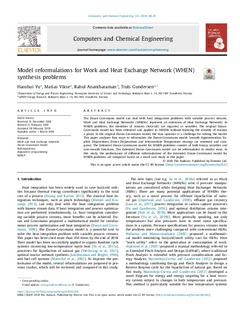| dc.contributor.author | Yu, Haoshui | |
| dc.contributor.author | Vikse, Matias | |
| dc.contributor.author | Anantharaman, Rahul | |
| dc.contributor.author | Gundersen, Truls | |
| dc.date.accessioned | 2020-01-16T09:04:54Z | |
| dc.date.available | 2020-01-16T09:04:54Z | |
| dc.date.created | 2019-03-15T13:06:36Z | |
| dc.date.issued | 2019 | |
| dc.identifier.citation | Computers and Chemical Engineering. 2019, 125 89-97. | nb_NO |
| dc.identifier.issn | 0098-1354 | |
| dc.identifier.uri | http://hdl.handle.net/11250/2636564 | |
| dc.description.abstract | The Duran-Grossmann model can deal with heat integration problems with variable process streams. Work and Heat Exchange Networks (WHENs) represent an extension of Heat Exchange Networks. In WHEN problems, the identities of streams (hot/cold) are regarded as variables. The original Duran-Grossmann model has been extended and applied to WHENs without knowing the identity of streams a priori. In the original Duran-Grossmann model, the max operator is a challenge for solving the model. This paper analyzes four ways to reformulate the Duran-Grossmann model. Smooth Approximation, Explicit Disjunctions, Direct Disjunctions and Intermediate Temperature strategy are reviewed and compared. The Extended Duran-Grossmann model for WHEN problems consists of both binary variables and non-smooth functions. The Extended Duran-Grossmann model can be reformulated in similar ways. In this study, the performance of different reformulations of the Extended Duran-Grossmann model for WHEN problems are compared based on a small case study in this paper. | nb_NO |
| dc.language.iso | eng | nb_NO |
| dc.rights | Navngivelse 4.0 Internasjonal | * |
| dc.rights.uri | http://creativecommons.org/licenses/by/4.0/deed.no | * |
| dc.subject | Work and heat exchange networks | nb_NO |
| dc.subject | Duran-Grossmann model | nb_NO |
| dc.subject | Reformulations | nb_NO |
| dc.subject | disjunctive programming | nb_NO |
| dc.subject | MINLP | nb_NO |
| dc.title | Model reformulations for Work and Heat Exchange Network (WHEN) synthesis problems | nb_NO |
| dc.type | Journal article | nb_NO |
| dc.type | Peer reviewed | nb_NO |
| dc.description.version | publishedVersion | nb_NO |
| dc.rights.holder | The Authors | nb_NO |
| dc.source.pagenumber | 89-97 | nb_NO |
| dc.source.volume | 125 | nb_NO |
| dc.source.journal | Computers and Chemical Engineering | nb_NO |
| dc.identifier.doi | 10.1016/j.compchemeng.2019.02.018 | |
| dc.identifier.cristin | 1685065 | |
| dc.relation.project | Norges forskningsråd: 257632 | nb_NO |
| cristin.unitcode | 7548,60,0,0 | |
| cristin.unitname | Gassteknologi | |
| cristin.ispublished | true | |
| cristin.fulltext | postprint | |
| cristin.qualitycode | 2 | |

